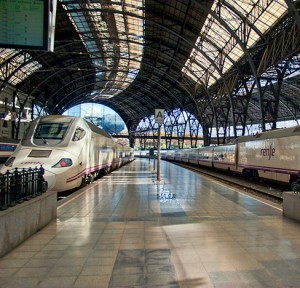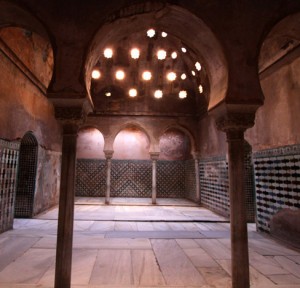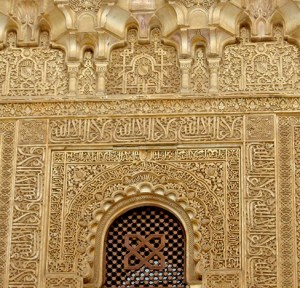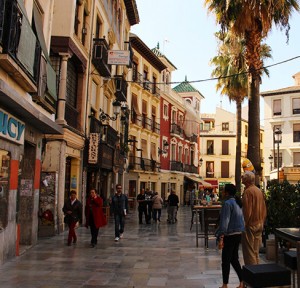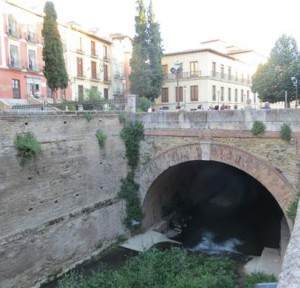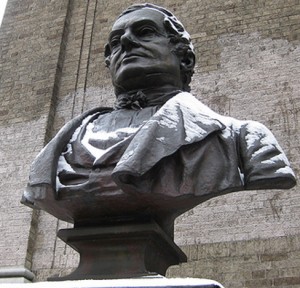Wanderlusting Alhambra
Sitting on a high chair, sipping hot cappuccino served by a beautiful waitress dressed in black with a Spanish accent that reminds of Tarar sahib’s half real half woven fairy worlds of magnificent godly and human treasures, I was talking to my friend in Multan while gazing at an ancient painting of old Moorish house in a city of Cordoba with fountain in its backyard watering a bunch of colorful flowers. Barcelona subway station was as open and busy as I thought it would be. I had to admit, I was hungry but the famous food chains there contained ingredients were baleful to my religious integrity, the ruins and remains of which I was planning to visit in Alhambra. I told my friend that the Renfe train to Granada is my dream journey towards the palace of red, built by Moors and soon it’s going to take a shape of reality. Being aware and part of some of my adventures, he certainly knew what I meant and shared with me some of the routine clergy and happenings in our home town. Freshly baked brown cookies and coffee served the purpose of my breakfast to start a journey to the valley of Sierre Nevada Mountains where the bay of Gibraltor stands erect as a testimony to a rise and fall of empire’s journey from the deserts of Africa to lush green lands of Europe across the waters of Mediterranean that introduced a culture of science and art, music and philosophy, mathematics and physics to the modern world.
I was early at station and spent almost an hour inside a book & DVD shop. Love for music and literature was evident from every corner of the place and I contributed towards it by buying CD of Pópera Gala Latina, the words are non-familiar but language is universal, that of same harmony and culture among music lovers who enjoy it without any barriers of language or understanding. The terminal of train to Granada was least inhabited with relatively a low number of passengers as compared to terminals for other cities of Spain like Madrid, Seville or Valencia. As the final warning for departure of train to Granada started appearing on a schedule board, and overhead announcements heard of the same, I headed towards the terminal with my rucksack comfortably placed on my back and soon I was in the line of boarding passengers, perhaps the only Asian to board on train towards Granada.
The journey itself was like once in a lifetime experience. To my utter disbelief, there was segregation of male and female compartments. All those stories of European train rides that were slowly weaving up in my mind suddenly shattered in a thrust of finding myself in a male only compartment piled up with berths on opposite walls of bogie. A loving old couple was sitting, gossiping and as soon as a whistle blew, the lady departed only to return back with a cup of tea for her husband at every stop. The gentleman introduced himself as Mr. Alan from a country near South Africa, Botswana. He and his wife were on a world tour after handing over their farms to their daughter and son in law. He told me amazing stories of his journey throughout different parts of the world, including the Christian pilgrimage (the Way of St. James) from a small church in France, Camino Frances, to the cathedral of Santiago de Compostela in Northern Spain. It’s a path that Christians take on feet, about 500 kilometers, and at each stop, priest gives them the certificate of heaven or hell in a town church. It was a night full of jokes, explorations and insight into different cultures, and when I fell asleep, it was already near dawn. After almost two hours of sleep, I woke up by rays of glowing sun entering through the train window. It was a beautiful morning in the suburbs once again reaffirming in my deep neuronal cortical pathways that I was indeed heading towards Granada.
It was a small remote railway station with only one washroom in farthest corner where I refreshed myself with a free splash of water over my face and brushing my teeth. As I came out, Mr. and Mrs. Alan embraced me with a smile and offered to join them in exploring the city which I politely refused. My next search was an information center for tourists but as suspected, it was very difficult to extract any solid information in English from the man behind the counter apart from pointing towards the taxi stand outside the station.
Again in the language of gestures, I told taxi driver to take me to “Alhambra”. The city was waking up from another peaceful night and life was about to start for yet another busy day. The mosaic pattern of tiles on the steeping streets of Granada strikingly caught my attention. After about half an hour, we were on the gates of the palace only to find a long queue in front of its gates.The biggest challenge was to get tickets for Nasrid palaces as there was only a limited access for a single day and these are sold on first come first get basis, but fortunately I was among those who got the general admission ticket including visits to Alcazaba, Partal, Generalife and Nasrid palaces. After taking a patties and tea from a gift & book shop located near the entrance pavilion, I began my walk inside the gardens of Alhambra.
Any fairy tale in the Disney world books, any worldly description of heavenly place and any mentioning of the historic palaces of princes and princesses cannot explain the grandeur, beauty, vastness and magic of red palace, built by Muhammad I Al – Ahmar, who built his court on the hills of Sabika in 1238 and hence began the construction of the great Alhambra. As you travel from one part to another, the magic of the palace starts gripping you and reaches its peak within Nasrid Palace. The shadows of brownish green leaves falling on streams of fresh waters from river Daroo, containing fish of silver orange color, the ruins of the baths of the mosque, watch tower, court of the myrtles, court of the water channel, water stairway, gate of pomegranates and gate of justice simply swipe you away in some other world. The mosque baths of Alhambra were built in early 14th century at the time of Muhammad III, for the Mosque of the city of the Alhambra, which was right where the church of Santa Maria de la Alhambra stands today.
The general structure of this bath does not follow the traditional model of the caliphate (8th to 11th centuries) in which rooms were situated in a parallel distribution but rather has a very unusual configuration. It is divided into cold room, temperate room and a warm room. One enters into a small, cold room, covered with a vault of four vertical planes through an archway at the northeast corner after which one approaches the vaulted temperate room. From there, we reach the rectangular warm room, with lateral alcoves separated by horseshoe arches and with one fount of immersion at present, although it is probable that there used to be a second one on the opposite side of the room. In the center is the space for the cauldron and we see brick baths on the floor of the warm room. A water channel connected to the large outdoor reservoir, near the Partal, guaranteed abundant water to this bath. Amid tall myrtles, this is a charming hill of small houses, luxurious villas and fragrant walls covered in jasmine, with the faint sound of hidden water said to be the weeping of poets, running slowly through streams below the roses and acanthuses.
It was in Generalife, where I laid down on a wooden bench under a deep cool shadow of a tree in a scorching sun of May, the sounds of hummingbirds and cuckoos chirping and the soothing flow of water sprouting from fountains, merging myself in a state of calmness and self amnesia, that I felt the world is immersing in a phase of transition between allure and real. My conscience took me in thirteenth century where I saw lovers hiding in the gardens of Alhambra, singers singing sweet melodies, mathematicians solving the algorithms of algebra, dancers dancing their soul and heart behind the curtains, poets reciting their masterpieces, scholars lecturing the knowledge seekers, astronomers peeping into the hidden worlds of galaxies and rulers plotting the coups. The lower gardens, the palace of the Generalife and the upper gardens were designed to be the lucrative shadowy recreational areas for the kings of Granada, where they escaped from the routines of ruling the kingdom and it serves this purpose even today except kings are replaced with ordinary visitors. Patio de la Acequia (Court of the water channel), Patio de la Sultana (Court of the Sultana) and Patio de Descabalgamieno (Court for dismounting) are some of the other worth mentioning places here. The trance of Alhambra took me in its spell and I continued my journey of exploring this magnificent piece of culture and history that still stands on the heart of earth as a matrimonial of human wealth and wisdom being ruined in conflicts of religion and war.
Alcazaba is the oldest part of Alhambra that served as the military area of the complex. Here I met two Arab friends. Being uncommon for our fellow Arabs to wander in places of historic significance other than in giant shopping malls of Dubai or beaches of western origin, I asked them what brought them there. They were doctors who came there to attend a medical conference in the nearby city of Granada and were oblivious to see the God promised rule of Muslims on the world going into the hands of Kafirs. Alcazaba was built like a fort hosting Torre de la Vela (Watch tower), Torre de la Pólvora (Gunpowder tower), Torre del Cubo (Round tower) and wall walk garden, reflecting the military strength and strategic importance of the area surrounded by the mountains of Sierre Nevada, currently the region of Andalucia, present day provinces of Granada and Almería in Spain. (Fig.7-10)
The beauty of Alhambra touches its plateau in Nasrid Palaces. You are not allowed to take any other items apart from your cell phone or camera inside. No words in any dictionary written so far have the ability to explain its charisma. The symmetry of the arches, reflection of the palace onto its waters, calligraphy on the tiles, water stairways with flumes (inverted roof tiles) conducting water from the royal water channel constantly from the ancient river Darro, that still flows without any electro-hydraulics even upto the top of fort, the palace of the lions and the Comares palace take you in a romantic world from where you never want to come back. The earthly knowledge and divine forces do some ultimate trick here to present a masterpiece to your eyes whose existence is the ultimate fortune of one’s desire to see heaven on the earth. It doesn’t need a consciousness to admire its beauty but alas, you have to make a part of your brain numb to feel its spell of magic. You can only absorb the panorama by letting yourself float on the tides of a river half awake, half sleeping.
Roaming as a vagabond for a scenic look of Alhambra at the time of sunset where sun throws its gloomy beams at the minarets of palace was another dream in my mind. The search for this view took me into the streets of Granada, into the narrow zigzag paths, where the fountains and backyard grape trees were visible through the half opened doors of the ancient Moorish era homes.
I saw a young man writing names of travelers in a beautiful Arabic calligraphy while walking through one of the streets and paid him some Euros to get all of my family member names crafted on a chart paper as a reminding souvenir. Sitting over one of the bridges on Darro, I heard someone speaking in Punjabi accent over his phone.
Later on, he turned out to be Bilal from Gujranwala. Meeting a fellow Pakistani in a land where there are approximately two hundred muslims in total was really a happy surprise. We met his father and both of them took me around after having a cup of tea filled with taste of their hospitality, to the towns and streets of Granada, definitely with a much better knowledge of the city serving as my guides also. Eating burger at one of the Pakistani shopkeeper’s burger shop hailing from Sialkot was a tremendous experience, and it made me really grateful to him when he refused to take any money for it. Finally when they left me at a railway station to catch my train to Barcelona, I was thinking that I may not see these people again in my life but the warmth of their hospitality and the sense of belonging they showed me, will remain with me for the rest of my life. Leaving Granada was like waking up from a sweet dream, from which you don’t want to wake up and try to remain under its trance for as long as possible but unfortunately you have to get up, just to continue with another daily routine of chores. Later on when I read the “Tales of Alhambra” by Washington Irving, that I bought from book store facing the front gate of Alhambra, it was revealed on me that I was not wrong in feeling that Alhambra can only be interpreted in a mystical world, no rules of geometry, engineering or Algebra in real world alone can explain its existence.


